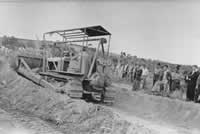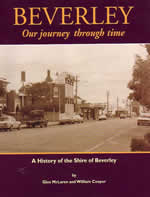Beverley History

The Shire of Beverley acknowledges the Ballardong Noongar people who are the Traditional Owners of this Land and their continuing connection to land, waters and community. We pay our respect to the Elders past, present and emerging and we extend that respect to other First Australians today.
For thousands of years the Ballardong Noongar have inhabited the the region along the Avon (Colguler) River and Dale (Boyagurring Bilya) River and have a deep attachment to their country.
The Ballardong people are a specific Noongar language group east of Perth. The Ballardong region includes the towns of Northam, York, Beverley, Goomalling, Cadoux, Koorda, Wyalkatchem, Cunderdin and Kellerberrin.
The European history of the Beverley district goes back to around 1831, only two years after European settlement of Western Australia. In this year, the first land grants were issued, with the name 'Beverley' having been attributed to Colonial Surgeon Charles Simmons, who was born in Beverley, Yorkshire in the United Kingdom and was one of the first landowners in the district.
Clearing of land for farming began in earnest in the 1860's and 1870's. However, it took until the 1950's and the advent of mechanised clearing to open up the last parts of the current farming area. Indeed, clearing of the native bushland to allow for farming continued until the 1970's.
Settlement of the Beverley district took several decades to take off from its modest beginnings. The coming of the government railway from Perth in 1886 began a period of growth in the town and surrounding farming areas that lasted until the middle of the 20th Century. With the extension of the railway to Albany in 1889, Beverley became an important railway centre. This is now just a memory, the last railway staff being transferred away from the town in 1984. In its heyday, the town sported a large railway complex with refreshment rooms, engine and goods sheds and a large workforce to operate the trains and maintain the line.
 The growing community was boosted in 1908 by the extension of the world famous Goldfields Water Supply Scheme to the district. This supply still serves the town today, with the silver pipeline following the road down from York. The spark of electricity came to the town in 1913 with the opening of the first powerhouse. The town supplied its own power until it was connected to the State power grid in 1966.
The growing community was boosted in 1908 by the extension of the world famous Goldfields Water Supply Scheme to the district. This supply still serves the town today, with the silver pipeline following the road down from York. The spark of electricity came to the town in 1913 with the opening of the first powerhouse. The town supplied its own power until it was connected to the State power grid in 1966.
By the First World War, the town was a thriving community with a well-established business centre. Four hotels, four banks, two bakeries, two tailors, three tearooms, a jeweller and two hairdressers, to name but a few could be found in the town.
Beverley entered a period of stability after the First World War, tempered by the Great Depression of the early 1930's as was most of the world at that time. The community was able to celebrate the end of hard times in 1938 with the opening of the Town Hall and Picture Gardens. Other public buildings were modernised at this time, notably the Hotel Beverley, which had its façade reconstructed to reflect the 'Art Deco' style that was popular at the time.
With changes in farming practises due to increased mechanisation, the population of the Shire began to dwindle in the 1950's. The population decreased from around 2050 in 1954 and almost 2000 in 1961 to just over 1,700 in 1966. By 1990, the population was a little over 1450.
Improvements in transport and communications meant that the district did not have to be so self sufficient anymore and a number of services shut down, such as the local newspaper The Beverley Times, all but one bank and other businesses that were unable to compete with businesses in Perth.
However, since the mid 1990's, the population had begun to grow again. Unlike many other rural areas, the proximity to Perth and its attraction as a safe and clean place to live has meant the population is again over 1700 for the first time in several decades.
In 2002, the book Beverley, Our Journey Through Time was published. This quality hard cover book of some 250 pages is available from the Community Resource Centre for $25.00 plus $15.00 postage anywhere in Australia (prices include GST). Contact the CRC Office 9646 1600.